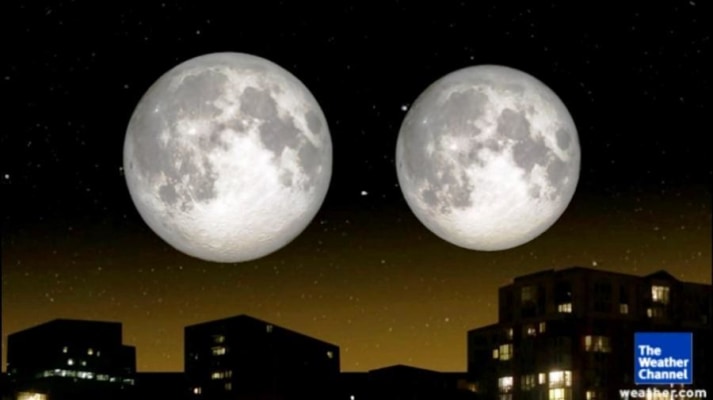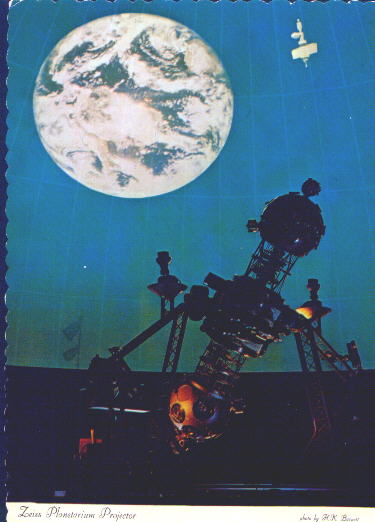 The Weather Channel
The Weather Channel
Reporting for SpaceWatchtower
At the moment of the posting of this blog post, Monday Evening, 2014 September 8 at 9:38 p.m. EDT / September 9, 1:38 Coordinated Universal Time (UTC), marks the Full Moon of September, which is also the Harvest Moon for 2014 and the third and last so-called 'SuperMoon' of the year.
This month's Full Moon is considered by some a 'SuperMoon' because, like the Full Moons of July and August (the August Full Moon was the largest 'SuperMoon' of 2014), the Full Moon is closer to the Earth than normal - a perigee-Full Moon. Actually, this month's lunar perigee, the point in the Moon's orbit when it is closest to the Earth, occurred this morning at Midnight EDT (4:00 UTC), when the Moon was 358,389 kilometers from the Earth. At the time of a perigee-Full Moon, such as today, larger than usual tides are predicted along ocean coastlines.
Since the Moon is closer to Earth than it typically is, the Moon looks a bit larger than usual in the sky, particularly near the horizon during Moon rise and Moon set (actually, the Moon always looks a little bigger during Moon rise and Moon set, as a person's vision then compares the size of the Moon to other objects near the horizon).
Often, but not always (usually, two out of every three years), the September Full Moon is considered the Harvest Moon. The Harvest Moon is the Full Moon closest to the Autumnal Equinox, when the season of Autumn or Fall officially begins, usually September 22 or 23. This year the Autumnal Equinox occurs Monday Evening, 2014 September 22 at 10:29 p.m. EDT / September 23 at 2:29 UTC.
So, the Harvest Moon, in general, can occur from two weeks before the Autumnal Equinox to two weeks after the beginning of Fall. When the October Full Moon occurs early in the month, it is then sometimes considered the Harvest Moon. The October Full Moon, which is usually the first Full Moon after the Harvest Moon, is usually considered the Hunter's Moon, providing hunters with additional light to hunt game after sunset. When the October Full Moon is considered the Harvest Moon, some still consider it the Hunter's Moon as well, while others then consider the November Full Moon the Hunter's Moon.
Occurring in the late Summer or early Autumn, in September or October in the Northern Hemisphere, the Harvest Moon provides farmers with additional light in the early evening, during the very busy harvest time. The Harvest Moon has the same characteristics in the Southern Hemisphere, when it occurs in March or April.
On average, throughout the year, the Moon rises 50 minutes later each day. However, this lag time between successive Moon rises shrinks to an annual minimum near the Full Moon closest to the Autumnal Equinox. This greatly reduced lag time averages between 25 and 35 minutes throughout most of the United States, and as little as 10 to 20 minutes for Canada and much of Europe, each day for several days around the time of the Full Moon. Hence, for a few days around the date of the Harvest Moon, there is little or no period of darkness between sunset and Moon rise. This provides farmers with several days of extra, uninterrupted, light after sunset, for completing the harvest (of course, weather-permitting).
In the Northern Hemisphere, the September Full Moon is also known as the Corn Moon, Fruit Moon, Wild Rice Moon, and Red Plum Moon.
The September Full Moon has been given several names in the Southern Hemisphere: Worm Moon, Lenten Moon, Crow Moon, Sugar Moon, Chaste Moon, and Sap Moon.
More on the so-called "SuperMoon": Link >>> http://en.wikipedia.org/wiki/Supermoon
More on the Full Moon: Link >>> http://en.wikipedia.org/wiki/Full_moon
More on Full Moon names ---
Link 1 >>> http://earthsky.org/astronomy-essentials/full-moon-names
Link 2 >>> http://en.wikipedia.org/wiki/Full_moon#Harvest_and_Hunter.27s_moons
Link 3 >>> http://www.farmersalmanac.com/full-moon-names/
Source: Glenn A. Walsh, Reporting for SpaceWatchtower, a project of Friends of the Zeiss.
2014: 75th Year of Pittsburgh's Buhl Planetarium

Want to receive SpaceWatchtower blog posts in your inbox ?
Send request to < spacewatchtower@planetarium.cc >..
gaw
Glenn A. Walsh, Project Director,
Friends of the Zeiss < http://buhlplanetarium.tripod.com/fotz/ >
Electronic Mail - < gawalsh@planetarium.cc >
SpaceWatchtower Blog: < http://spacewatchtower.blogspot.com/ >
Also see: South Hills Backyard Astronomers Blog: < http://shbastronomers.blogspot.com/ >
Barnestormin: Writing, Essays, Pgh. News, & More: < http://www.barnestormin.blogspot.com/ >
About the SpaceWatchtower Editor / Author: < http://buhlplanetarium2.tripod.com/weblog/spacewatchtower/gaw/ >
SPACE & SCIENCE NEWS, ASTRONOMICAL CALENDAR:
< http://buhlplanetarium.tripod.
Twitter: < https://twitter.com/spacewatchtower >
Facebook: < http://www.facebook.com/pages/
Author of History Web Sites on the Internet --
* Buhl Planetarium, Pittsburgh:
< http://www.planetarium.
* Adler Planetarium, Chicago:
< http://adlerplanetarium.
* Astronomer, Educator, Optician John A. Brashear:
< http://johnbrashear.tripod.com >
* Andrew Carnegie & Carnegie Libraries:
< http://www.andrewcarnegie.
* Civil War Museum of Andrew Carnegie Free Library:
< http://garespypost.tripod.com >
* Duquesne Incline cable-car railway, Pittsburgh:
< http://inclinedplane.tripod.
* Public Transit:
< http://andrewcarnegie2.tripod.
No comments:
Post a Comment